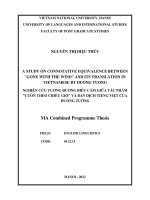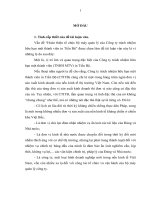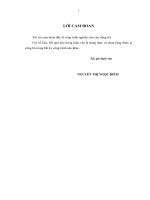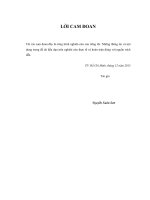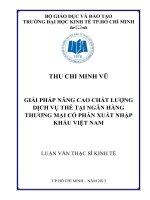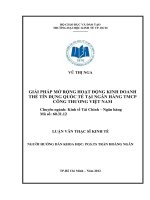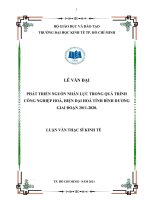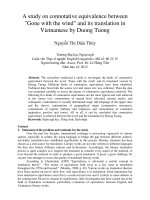(Luận văn thạc sĩ) a study on connotative equivalence between gone with the wind and its translation in vietnamese by duong tuong m a thesis linguistics 60 22 1
Bạn đang xem bản rút gọn của tài liệu. Xem và tải ngay bản đầy đủ của tài liệu tại đây (818.51 KB, 77 trang )
VIETNAM NATIONAL UNIVERSITY, HANOI
UNIVERSITY OF LANGUAGES AND INTERNATIONAL STUDIES
FACULTY OF POST GRADUATE STUDIES
NGUYỄN THỊ DIỆU THÚY
A STUDY ON CONNOTATIVE EQUIVALENCE BETWEEN
"GONE WITH THE WIND" AND ITS TRANSLATION IN
VIETNAMESE BY DUONG TUONG
NGHIÊN CỨU TƯƠNG ĐƯƠNG BIỂU CẢM GIỮA TÁC PHẨM
"CUỐN THEO CHIỀU GIÓ" VÀ BẢN DỊCH TIẾNG VIỆT CỦA
DƯƠNG TƯỜNG
MA Combined Programme Thesis
FIELD:
ENGLISH LINGUISTICS
CODE:
60.22.15
HANOI - 2012
VIETNAM NATIONAL UNIVERSITY, HANOI
UNIVERSITY OF LANGUAGES AND INTERNATIONAL STUDIES
FACULTY OF POST GRADUATE STUDIES
NGUYỄN THỊ DIỆU THÚY
A STUDY ON CONNOTATIVE EQUIVALENCE BETWEEN
"GONE WITH THE WIND" AND ITS TRANSLATION IN
VIETNAMESE BY DUONG TUONG
NGHIÊN CỨU TƯƠNG ĐƯƠNG BIỂU CẢM GIỮA TÁC PHẨM
"CUỐN THEO CHIỀU GIÓ" VÀ BẢN DỊCH TIẾNG VIỆT CỦA
DƯƠNG TƯỜNG
MA Combined Programme Thesis
FIELD:
English Linguistics
CODE:
60.22.15
SUPERVISOR: Assoc. Prof. Dr. LÊ HÙNG TIẾN
HANOI - 2012
TABLE OF CONTENTS
DECLARATION ……………………………………………………....i
ACKNOWLEDGEMENT…………………………………………….ii
ABSTRACT……………………………………………………………iii
PART A: INTRODUCTION…………………………………………..1
I. Statement of the problem and rationale for the study…………………1
II. Research aims and research questions…………………………………2
III. Scope of the study…………………………………………………….3
IV. Methods of the study………………………………………………….3
PART B: DEVELOPMENT…………………………………………….5
CHAPTER 1: LITERATURE REVIEW………………………………5
1.1. Definition of translation……………………………………………….5
1.2. Translation equivalence……………………………………………….6
1.2.1. Jakobson and the concept of equivalence in difference………6
1.2.2. Nida and Taber's Formal dynamic equivalence………………7
1.2.3. Catford and translation shifts………………………………...10
1.2.4. Kade and quantitative equivalence …………………………..11
1.2.5. Baker's approach to translation equivalence………………….12
1.2.6. Koller's theory of equi
iv
In this procedure, the meaning of the original word is explained by several
target language word.
1.5.7.
Synonymy
This procedure is used for a source language word where there is no clear
one ±to ±one equivalent, and the word is not important in the text, in particular for
adjectives or adverbs of quality. A synonym is only appropriate where literal
translation is not possible,
1.5.8. Through translation
Through translation is the literal translation of common collocations, names
of organizations. Normally, this procedure should be used only when they are
already recognized terms.
1.5.9. Shifts or transpositions
This procedure involves a change in the grammar from source language to
target language. This procedure may be used when a source language grammatical
structure does not exist in the target language, or when literal translation is
grammatically possible but may not accord with natural usage in the target
language. Another kind of transpositions is the replacement of a virtual lexical gap
by a grammatical structure. Transposition is the only procedure concerned with
grammar.
1.5.10. Modulation
Modulation is defined as a variation through a change of viewpoint, of
perspective, and of catergory of thought. There are several types of modulation,
such as "positive for double negative", "part for the whole", "abstract for concrete",
"cause for effect", "one part for another", "active for passive", "reversal of terms",
"change of symbols".
20
1.5.11. Compensation
This occurs when loss of meaning, sound-effect, metaphor or pragmatic effect in
one part of a sentence is compensated in another part, or in a contiguous sentence.
1.5.12. Componential analysis
This is the splitting up of a lexical unit into its sense components, often one-to-two,
-three or –four translatios.
1.5.13. Paraphrase
This is an amplification or explanation of the meaning of a segment of the text. It is
used in an "anonymous" text when it is poorly written, or has important
implications or omissions.
1.5.14. Couplets
Couplets, triplets, quaderuplets combine two, three or four of the above mentioned procedures respectively for dealing with a single problem. They are
particularly common for cultural words
1.6. The author Margaret Mitchell and the novel “Gone with the wind”
1.6.1. The author Margaret Mitchell
Margaret Mitchell was the author of “Gone with the wind”. Published in
1936, the novel sold more than a million copies in the first six months, which was
phenomenal considering it was the Great Depression era. Margaret Mitchell was
awarded the Pulitzer Prize for the book in 1937. More than 30 million copies have
been sold worldwide in thirty-eight countries. It has been translated into twentyseven languages. Every year, there are approximately 250,000 copies are still sold.
Margaret Munnerlyn Mitchell was born on November 8, 1900, in Atlanta. A
number of her family members had fought in wars, which can partly explain why
the setting of “Gone with the wind” is the Civil War. Mitchell‟s mother's family
21
was Irish Catholic. Her great-grandfather Phillip Fitzgerald came to America from
Ireland and eventually settled on a plantation near Jonesboro in Fayette County.
These details were all portrayed in her characters in the novel.
From 1914 to 1918 Mitchell attended the Washington Seminary, a
prestigious Atlanta finishing school, where she was a founding member and officer
of the drama club. She was also the literary editor of Facts and Fancies, the high
school yearbook. She was president of the Washington Literary Society.
At a dance in the summer of 1918 Mitchell met Clifford Henry, a wealthy
and socially prominent from New York. The two fell in love and became engaged
shortly before he was shipped overseas. He was killed in October 1918 while
fighting in France.
In September 1918 Mitchell entered Smith College in Northampton,
Massachusetts, where she began using the nickname "Peggy". In January her
mother contracted influenza and died the day before her daughter reached home.
Mitchell completed her freshman year at Smith, then returned to Atlanta to take her
place as mistress of the household and to enter the upcoming debutante season.
Soon Mitchell met Berrien Kinnard Upshaw, who was from a prominent
Raleigh, North Carolina, family. They were wed in 1922, but the marriage was
brief. After four months Upshaw left Atlanta for the Midwest and never returned.
The marriage was annulled two years later.
In the same year that she married, Mitchell landed a job with the Atlanta
Journal Sunday Magazine. She used "Peggy Mitchell" as her byline. Her
interviews, profiles, and sketches of life in Georgia were well received. During her
four years with the Sunday Magazine, Mitchell wrote a huge number of articles,
22
worked as a proofreader, substituted for the advice columnist, reviewed books.
However, complications from a broken ankle led her to end her career as a
journalist.
Mitchell's second marriage was to John Robert Marsh on July 4, 1925. In
1926, to relieve the boredom of being cooped up with a broken ankle, Mitchell
began to write Gone With the Wind. She completed the majority of the book in
three years. She wrote the last chapter first and the other chapters in no particular
order. She eventually accumulated almost seventy chapters.
In April 1935 Harold Latham, an editor for the Macmillan publishing
company in New York City, toured the South looking for new manuscripts.
Latham heard that Mitchell had been working on a manuscript and asked her if he
could see it, but she denied having one. When a friend commented that Mitchell
was not serious enough to write a novel, Mitchell gathered up many of the
envelopes and took them to Latham at his hotel. He had to purchase a suitcase to
carry them. He read part of the manuscript on the train to New Orleans, Louisiana,
and sent it straight to New York. By July Macmillan had offered her a contract.
She received a $500 advance and 10 percent of the royalties.
As she revised the manuscript, Mitchell cut and rearranged chapters,
confirmed details, wrote the first chapter, changed the name of the main character
(originally called Pansy), and struggled to think of a title that suited her. Titles
considered included Tomorrow Is Another Day, Another Day, Tote the Weary
Load, Milestones, Ba! Ba! Blacksheep, Not in Our Stars, and Bugles Sang True.
Finally she settled on a phrase from a favorite poem “I have forgot much, Cynara!
gone with the wind, / Flung roses, roses riotously with the throng.” Published in
1936, Gone With the Wind was 1,037 pages long and sold for three dollars.
23
Gone With the Wind was a phenomenal success and received rave reviews.
Overnight, Mitchell became a celebrity and remained very much in the public
spotlight through the production and premiere of the film based on her novel in
1939. She was in constant demand for speaking engagements and interviews.
Gone With the Wind was Mitchell‟s only published novel. At her request, the
original manuscript and all other writings were destroyed. Possibly one of the
reasons that Mitchell never wrote another novel was that she spent so much time
working with her brother and her husband to protect the copyright of her book
abroad. Up until the publication of Gone With the Wind, international copyright
laws were ambiguous and varied from country to country. Correspondence also
took much of her time. During the years following publication, she personally
answered every letter she received about her book. With the outbreak of World
War II (1941-45), she worked tirelessly for the American Red Cross, even
outfitting a hospital ship. She also set up scholarships for black medical students.
On August 11, 1949, Mitchell and her husband decided to go to a movie, A
Canterbury Tale, at the Peachtree Art Theatre. Just as they started to cross
Peachtree Street, near 13th Street, Mitchell was hit by a speeding taxi. She was
rushed to Grady Hospital but never regained consciousness. During the five days
before she died, crowds waited outside for news. U.S. president Harry Truman,
Georgia governor Herman Talmadge, and Atlanta mayor William B. Hartsfield all
asked to be kept informed of her condition. Special phone lines were installed at
Grady Hospital, and friends manned the lines in four-hour shifts. Mitchell died on
August 16, 1949, and was buried in Oakland Cemetery in Atlanta.
1.6.2. The novel “Gone with the wind”
24
Scarlett O‟Hara, a pretty Southern belle, lives on Tara, a large plantation in
Georgia. She concerns herself only with her numerous suitors and her desire to
marry Ashley Wilkes. One day she hears that Ashley is engaged to Melanie
Hamilton, his frail, plain cousin from Atlanta. At a barbecue at the Wilkes
plantation the next day, Scarlett confesses her feelings to Ashley. He tells her that
he does love her but that he is marrying Melanie because she is similar to him,
whereas he and Scarlett are very different.
The Civil War begins. Charles Hamilton, Melanie‟s timid, dull brother,
proposes to Scarlett. She spitefully agrees to marry him, hoping to hurt Ashley.
Over the course of two months, Scarlett and Charles marry, Charles joins the army
and dies of the measles, and Scarlett learns that she is pregnant. After Scarlett
gives birth to a son, Wade, she becomes bored and unhappy. She makes a long trip
to Atlanta to stay with Melanie and Melanie‟s aunt, Pittypat. The busy city agrees
with Scarlett‟s temperament, and she begins to see a great deal of Rhett. Rhett
infuriates Scarlett with his bluntness and mockery, but he also encourages her to
flout the severely restrictive social requirements for mourning Southern widows.
As the war progresses, food and clothing run scarce in Atlanta. Scarlett and
Melanie fear for Ashley‟s safety. After the bloody battle of Gettysburg, Ashley is
captured and sent to prison, and the Yankee army begins bearing down on Atlanta.
Scarlett desperately wants to return home to Tara, but she has promised Ashley she
will stay with the pregnant Melanie, who could give birth at any time.
On the night the Yankees capture Atlanta and set it afire, Melanie gives birth
to her son, Beau. Rhett helps Scarlett and Melanie escape the Yankees, escorting
them through the burning streets of the city, but he abandons them outside Atlanta
so he can join the Confederate Army. Scarlett drives the cart all night and day
25
through a dangerous forest full of deserters and soldiers, at last reaching Tara. She
arrives to find that her mother, Ellen, is dead; her father, Gerald, has lost his mind;
and the Yankee army has looted the plantation, leaving no food or cotton.
Scavenging for subsistence, a furious Scarlett vows never to go hungry again.
Scarlett takes charge of rebuilding Tara. She murders a Yankee thief and
puts out a fire set by a spiteful Yankee soldier. At last the war ends, word comes
that Ashley is free and on his way home, and a stream of returning soldiers begins
pouring through Tara. One such soldier, a one-legged homeless Confederate
named Will Benteen, stays on and helps Scarlett with the plantation. One day, Will
brings terrible news: Jonas Wilkerson, a former employee at Tara and current
government official, has raised the taxes on Tara, hoping to drive the O‟Haras out
so that he might buy the plantation. Distraught, Scarlett hurries to Atlanta to seduce
Rhett Butler so that he will give her the three hundred dollars she needs for taxes.
Rhett has emerged from the war a fabulously wealthy man, dripping with earnings
from his blockade-running operation and from food speculation. However, Rhett is
in a Yankee jail and cannot help Scarlett. Scarlett sees her sister‟s beau, Frank
Kennedy, who now owns a general store, and forges a plan. Determined to save
Tara, she betrays her sister and marries Frank, pays the taxes on Tara, and devotes
herself to making Frank‟s business more profitable.
After Rhett blackmails his way out of prison, he lends Scarlett enough
money to buy a sawmill. To the displeasure of Atlanta society, Scarlett becomes a
shrewd businesswoman. Gerald dies, and Scarlett returns to Tara for the funeral.
There, she persuades Ashley and Melanie to move to Atlanta and accept a share in
her lumber business. Shortly thereafter, Scarlett gives birth to Frank‟s child, Ella
Lorena.
26
A free black man and his white male companion attack Scarlett on her way
home from the sawmill one day. That night, the Ku Klux Klan avenges the attack
on Scarlett, and Frank ends up dead. Rhett proposes to Scarlett and she quickly
accepts. After a long, luxurious honeymoon in New Orleans, Scarlett and Rhett
return to Atlanta, where Scarlett builds a garish mansion and socializes with
wealthy Yankees. Scarlett becomes pregnant again and has another child, Bonnie
Blue Butler. Rhett dotes on the girl and begins a successful campaign to win back
the good graces of the prominent Atlanta citizens in order to keep Bonnie from
being an outcast like Scarlett.
Scarlett and Rhett‟s marriage begins happily, but Rhett becomes
increasingly bitter and indifferent toward her. Scarlett‟s feelings for Ashley have
diminished into a warm, sympathetic friendship, but Ashley‟s jealous sister, India,
finds them in a friendly embrace and spreads the rumor that they are having an
affair. To Scarlett‟s surprise, Melanie takes Scarlett‟s side and refuses to believe
the rumors.
After Bonnie is killed in a horse-riding accident, Rhett nearly loses his mind,
and his marriage with Scarlett worsens. Not long after the funeral, Melanie has a
miscarriage and falls very ill. Distraught, Scarlett hurries to see her. Melanie makes
Scarlett promise to look after Ashley and Beau. Scarlett realizes that she loves and
depends on Melanie and that Ashley has been only a fantasy for her. She concludes
that she truly loves Rhett. After Melanie dies, Scarlett hurries to tell Rhett of her
revelation. Rhett, however, says that he has lost his love for Scarlett, and he leaves
her. Grief-stricken and alone, Scarlett makes up her mind to go back to Tara to
recover her strength in the comforting arms of her childhood nurse and slave,
Mammy, and to think of a way to win Rhett back.
27
1.7. The translator Duong Tuong and the translation “Cuốn theo chiều gió”
1.7.1. The translator Duong Tuong
Tran Duong Tuong was born in August 4th 1932 in Nam Dinh province.
Duong Tuong started his schooling at Nam Dinh. Then he moved to Hanoi to study
at secondary school. When the August Revolution broke out, Duong Tuong quit
school and became a focal point for Viet Minh (The Vietnam Revolutionary
League) in Vinh Yen. His family forced him to back to school. After several
months of studying at Phan Chu Trinh high school, he quit again and joined the
army in 1949.
In 1955, Duong Tuong was demobilized and has lived in Hanoi since then.
He went to old bookstores in Ba Trieu street, Sinh Tu street, Son Tay street to look
for good books. He spent most of his free time reading books in libraries.
Duong Tuong is a well – rounded artist. He is a translator, a poet, a
journalist, a music, theatre, literary, and movie critic.
He has translated more than 50 works of various languages, many of which
are great works, such as “Anna Karenina” (Lev Tolstoy), “Wuthering Heights”
(Emily Bronte), “Alexis Zorbas” (Nikow Kazantzakis), “The Tin Drum” (Gunter
Grass), etc. “Gone with the wind” is also translated by Duong Tuong for quite a
long time ago. However, this is considered the most successful translation of the
original novel.
1.7.2. The translation “Cuốn theo chiều gió”
“Cuốn theo chiều gió” was published in 1988 by Literature Publishing House and
since then has proved to be one of the most favourite novel of many generations.
Millions of copies have been sold and still there are requests for reprint even
28
though this book was first published more than 20 years ago. This is a huge
success which is not easy to achieve for many translated works.
29
CHAPTER 2 – DEVELOPMENT
As stated in the introduction, this part deals with different dimensions of
connotations as well as the procedures used to achieve equivalence. The
connotation dimensions are categorized according to Koller's theory, and each part
covers one type of connotative equivalence.
2.2.
Connotations of socially determined usage
The language used in “Gone with the wind” belongs to two ends, on the one
end is the language of the upper class, on the other end is that of the slaves, the
uneducated in the society. The distinct features in the language of the two classes
are clearly illustrated in the novel.
2.2.1. The language of the upper class
Language is one of the symbols of social class. Each class has its own and
unique style. In the novel, the upper class's language is highly formal, mainly
manifested by the use of formal grammatical structures and word choices. In order
to achieve this kind connotation, it is important for the translation to convey the
formality of the language in the translation. First of all, consider the following
examples taken from the novel. The formal expressions are italicized for better
illustration.
Example 1: I fear I cannot agree with you about Mr Thackeray‟s works. I fear he is
not the gentleman Mr Dickens is.
Translation: Em không thể đồng ý với anh về tác phẩm của Thackore. Em cho rằng
ông ta không phong lưu mã thượng như Đickenz.
Example 2: Gentlemen, may I say a word?
Translation: Thưa q vị, tơi có thể nói một câu được khơng?
Example 3: You promised to show me your library, sir. Would it be a too great
favor to ask to see it now?
30
Translation: Thưa ngài, ngài đã hứa là sẽ giới thiệu với tôi thư viên của ngài. Giả
dụ tôi muốn xem ngay bây giờ, có phải là địi hỏi q đáng không?
Example 4: Sir, you would have made known your presence.
Translation: Thưa ông, lẽ ra từ nãy ông phải lên tiếng cho biết là ơng đang ở đó.
Example 5: Ashley, you have not favoured us with your opinion!
Translation: Asli, anh chưa hạ cố cho chúng tôi biết ý kiến của anh
Example 6: Permit me! I hardly hoped that you would recall me, Miss O‟Hara!
Translation: Cho phép tôi…Tôi chẳng mấy hi vọng là tiểu thư cịn nhớ ra tơi, thưa
tiểu thư; Âuhero
Example 7: May I lead you to a window?
Translation: Tiểu thư cho phép tơi dìu ra cửa sổ?
Example 8: We must all give grateful thanks to the charming ladies whose
indefatigable and patriotic efforts
Translation: Tất cả chúng ta phải chân thành cảm ơn các vị phu nhân và tiểu thư
tuyệt vời đã cố gắng khơng biết mệt, với lịng u nước nồng nàn.
Example 9: I was greatly disturbed to hear of your recent conduct
Translation: Mẹ vơ cùng lo lắng khi nghe nói về hành vi của con gần đây.
Example 10: Accept, dear Madam, this token of my reverence for your courage
and do not think that your sacrifice has been in vain, for this ring has been
redeemed at ten times its values.
Translation: Bà thân mến, xin bà nhận cho biểu hiện này của lịng kính phục đối
với sự can đảm của bà và đừng nghĩ rằng bà đã hy sinh vơ ích, vì chiếc nhẫn này
được chuộc lại với số tiền gấp mười giá trị của nó.
In the source text, such expressions as “Gentlemen”, “Sir”, “May I….”, “I
was greatly disturbed….”, “favour us with…..”, "permit me", "I fear…" etc are the
illustrations of the formal language. Duong Tuong attaches great importance to this
31
feature of the source text and tries to reproduce this language feature in
Vietnamese. From the above examples, it can be seen that Duong Tuong focuses
on word choices of the translation to make this feature outstanding. He uses
expression like “thưa quý vị”, “thưa ngài”, “thưa ông”, “phu nhân”, “tiểu thư”, “hạ
cố”, “cho phép tôi”, “xin bà nhận cho”, which are formal expression in Vietnamese
and also often used by educated people. While the English language uses certain
expressions to denote formality of language, formality in Vietnamese are expressed
differently. Duong Tuong emphasizes the use of address terms in formal contexts
such as "quý vị", "ngài", "ông", "phu nhân", "tiểu thư" to convey the formality.
Formal words such as "hạ cố", "cho phép tôi", "chân thành cảm ơn" are also use to
create the equivalent effect. Reading the translation, the target readers can obtain
the understanding of the formal language of the upper class.
The most powerful and rich families in the novel are also the ones who own
the most number of slaves. In their culture, the black work for them in exchange of
food, shelter and care. Therefore, the Southern people consider it normal to own
slaves. When talking to their slaves, the upper class uses a different kind of
language, which is more informal and full of commands. Let‟s consider the
following examples:
Original sentences
Translated sentences
I‟m going to beat your hide off for that
Tao thì đánh tuốt xương mày ra vì cái
thói ấy bây giờ
You ain‟t going to get anything. Mày sẽ chẳng được ăn gì…Bởi vì mày
Because you are going home and tell phải về thưa với bà là chúng tao không
Ma that we won‟t be home for supper
về nhà ăn tối.
I‟ll make a hant out of you if you don‟t Nếu mày khơng ra khỏi xe thì tao sẽ
get out of this wagon.
biến mày thành ma
32
Now you hurry right straight back
Vậy mày phải đi thật nhanh, rồi về
thẳng đây, nghe chưa.
Never mind what she said
Chị ấy bảo gì tao khơng cần biết
And if you don‟t hurry back this time, Nếu lần này mày không khôn hồn mau
I‟ll skin you alive.
mau trở về, tao sẽ lột da sống đó.
I don‟t know. I‟m telling you to ask for Tao khơng biết vì thế tao mới bảo mày
news
đi hỏi tin.
And if you so much as breathe to her Và nếu mày thở ra một câu nào để cô ấy
where the fighting is, I‟ll sell you South biết là đang đánh nhau ở đâu, tao sẽ bán
as sure as gun‟s iron.
mày cho bọn mãi nô miền Nam, chắc
chắn như một với một là hai vậy.
You black liar – what do you mean?
Con cuội cái da đen này….mày nói thế
nghĩa là thế nào
Oh, hush!
Ồ, câm đi!
Well, I‟ll wear you out if you don‟t.
Được thế thì tao sẽ róc xương mày nếu
mày không đi
You‟ll go or I‟ll sell you down the river
Mày khơng đi thì tao đem bán mày cho
bọn mãi nô ở dưới hạ nguồn
Run, you goose
Chạy đi, đồ ngu
You‟re a fool nigger…and if I ever get Mày là một con nhọ vơ tích sự….Và
the use of my arm again, I‟ll wear this nếu tao mà còn cử động được cánh tay
whip out of you
thì tao sẽ đánh mày kỳ đến gẫy cái roi
này
Then hush
Thế thì câm mồm đi
Lights? Why is the house so dark, Pork? Đèn đóm đâu cả? Tại sao nhà tối om
Bring candles.
thế, Pork? Mang nến lại đây!
33
Short sentences, mostly in the form of commands with the intensive use of
simple words are the outstanding points of these examples. The slave owners give
commands and slaves are expected to obey them, no matter how tough they are.
Duong Tuong takes advantage of address terms to achieve connotative equivalence
in this case. While the English has only “I” and “you” to address each other in a
conversation, the addressing system of Vietnamese is far more complicated. Duong
Tuong employs this addressing system to fully convey the message expressed by
the original text. “Mày” and “tao” are used to indicate the relationship of people of
different social status. Expressions like “tao đánh tuốt xương mày ra”, “tao sẽ lột
da sống”, “câm mồm đi”, “đồ ngu” makes the target text sound very natural and
lively to target readers. Connotations of socially determined usage are achieved in
this case.
2.2.2. The language of the slaves
The slaves play an important role in the novel. Their presence actually
complements the culture and language of the novel. The slaves are black people
who work for the white in exchange for food, care for the rest of their life. They
are mostly uneducated without any schooling. Therefore, their language bears
different characteristics to that of their owners. Take a look at the following
examples:
Original sentences
Translated sentences
She quite down lak a bird w‟en de hawk Cơ í lặng đi dư con chim nhỏ thấy con
fly ober
diều hâu bay qua
Dey got a fe‟el han‟ cookin‟
Họ lấy một chị làm đồng về nấu thay
De niggers tells me she is the wustest Tụi nhọ cho biết đấy là người đầu bếp
cook in de state
tồi nhất bang
34
We ain‟ gwine git nothin‟ ter eat „cept Thầy trò ta sẽ chả có gì ăn ngồi thịt ơ –
possum an‟ greens
pơt (1) với dau sanh
(1) Lồi thú có túi đựng con, có
nhiều ở Bắc Mỹ
An‟ den she‟ll light on me lak a duck on Rồi thì bà xẽ nhảy bổ lên cháu dư diều
a Jane bug
hâu bổ xuống gà con
„cause Ah heap ruther de patterollers git Bởi chưng cháu thà bị tuần cha bắt còn
me dan Miss Beetriss when she in a hơn bị bà Biotrix túm gáy trong cơn
state
thịnh nộ
Me put on airs fo‟ dem cheap niggers
Cháu mà lại phải da vẻ ta đây với bọn
nhọ mạt hạng?
An‟ she out hyah now wanting ter speak Và nó đang đứng ngồi kia, mốn thưa
wid you
chuyện với ơng.
Dis Miss Scarlett, ain‟t it?
Tiểu thư Xcarlet phải không ạ?
Miss Scarlett, mek yo‟ cu‟tsy. Dar‟s Kìa, tiểu thư Xcarlet, đáp lễ đi. Bà
Miss Merriwether an‟ Miss Elsing a- Meriuezo và bà Elxing đang cúi chào
bowin‟ to you
tiểu thư đấy.
We air hungry. There won‟t be no crop Ở nhà đóy nắm. Lăm lay xẽ trẳng có mà
this year – their ain‟t nobody to plow. màng gì – trẳng có ai cài bừa cả. Đóy to
We air hungry
Gawdlmighty! Dar‟s Miss Scarlett
Lạy Trúa toàn năng!Tiểu thư Xcarlet
đây này!
No‟m, us ain‟t runned away. Dey done Không, xưa cơ, trúng tơi khơng có trạy
sont an‟ tuck us, kase us wuz de fo‟ trốn. Họ đến tìm và lơi trúng tơi đi, là vì
bigges‟ an‟ stronges‟ han‟s at Tara
trúng tôi là dững tay khỏe dứt, to dứt ở
Tara
35
Lawd, Miss Scarlett! Ain‟ you heerd? Lạy Trúa, Tiểu thư Xcarlet! Cô không
Us is ter dig de ditches fer de wite biết à? Chúng tôi phải đi đào hầm cho
gempmums ter hide in w‟en de Yankees các ông nhớn da chắng trốn khi bọn
Yanki đến.
comes.
Cose, Mis‟ Gerald might‟ nigh had a fit Cố diên, ông Giê -rơld thiếu chút nữa là
w‟en dey tuck me, an‟ he say he kain lên cơn khi họ bắt tôi đi, ông bảo thiếu
run de place without me.
Tek
him,
Mist‟
Kennedy.
tôi ông không cai quản được ấp chại.
De Lấy nó đi, ơng Kennơdi. Liên bang cần
Confedrutsy need Big Sam mo‟ dan us Bích Xam hơn trúng tơi. Và bà cho tôi
do. An‟ she gib me a dollar an‟ tell me một đô la, bảo tôi phải làm đúng dư lời
ter do jes‟ whut de w‟ite gempmums tell các ông da chắng bảo.
me.
Go do-ow, Mos – es! Waaa- ay, do- Hãy bước xuống, Môi-xe! Bước xuống
own, in Eeejup laa-an! An‟ te-el O- le E Cậ ậ ậ p!
Faa-ro-o Ter let mah – peee-pul go!
Và xin v-u-a Fa-r-a-ô-ô-n-g.
Cho dân trúng tôi đi
Ah‟s off ter de war, agin, Miss Scarlett. Tui lại lên đường da chận, tiểu thư
Dis time wid Ole Mist‟ John „stead ob Xcarlet! Lần này thì theo hầu ông cụ
Mist‟ Ashley
Jon, thay vì cậu Asli
Well‟m, Dey Cookie say Miss Meade Xưa cô, chị bếp bảo bà Mid xáng xớm
done got wud early dis mawnin‟ dat lay được tin cậu Phil chúng đạn bị
young Mist‟ Phil done been shot an‟ thương, cho lên bà Mid mới lấy xe, mời
Miss Meade she tuck de cah‟ige an‟ Ole ông bà Tolbet, mấy bà dà Betxi, tất cả
Talbot an‟ Betsy an‟ dey done gone ter cùng đi đón cậu í về nhà. Chị bếp bỉu
fotch him home. Cookie say he bad hurt cậu í bị thương lặng lắm, thành thử bà
an‟ Miss Meade ain‟t gwine ter be Mid trưa trắc có đến đây được
36
studyin‟ „bout „comin‟ up hyah.
Dey‟s
fightin‟
at
Johnboro,
Miss Oánh nhau ở Jơn–bơ- râu rồi, cô Xcarlet
Scarlett! Dey say our gempmums is ạ! Họ bỉu các ơng nhà ta bị thua dồi. Ơi,
gittin‟ beat. Oh, Gawd, Miss Scarlett! lạy Trúa, cô Xcarlet! Cô cháu mình xẽ
Whut‟ll happen ter Maw an‟ Poke? Oh, ra xao lếu bọn Yanki tới đây? Ôi, lạy
Gawd, Miss Scarlett! Whut‟ll happen ter Trúa….
us effen de Yankees gits hyah?
No‟m, he ain‟t at de horsepitte. Miss Xơ cơ, ơng í khơơng có ở bịnh vện. Bà
Merriwether an‟ Miss Elsing ain‟ dar Meriuezơ mấy bà Elxinh cũng khôông
needer. A man he tole me doctah down có ở đấy lốt. Có một người bỉu cháu là
by de car shed wid the wounded sojers ông bác sĩ đang ở ngoài ga mấy xơng
jes‟ come in frum Jonesbor, but Miss binh vừa trở từ Jơnzbơrâu đến, cơ mà xơ
Scarlett, Ah wuz sceered ter go down cô Xcarlet, cháu xợ không dám ra
dar ter de shed – dey‟s folkses dyin‟ ga…nhều người đang chết ở đấy. Cháu
down dar.
Ah‟s
sceered
of
daid xợ thấy người chết lắm!
folkses…
Miss Scarlett, fo‟ Gawd, Ah couldn‟ Xơ cơ Xcarlet, thề có Trúa, cháu khơơng
sceercely git one of dem ter read yo‟ làm thế lào để khến một ông bác xĩ lào
note. Dey wukin‟ in de horsepitte lak khác đọc thư của cơ. Các ơng í làm việc
dey all done gone crazy. One doctah he như đên ở bịnh vện. Có một ơng bác xĩ
say ter me, „damn yo‟ hide! Doan you bỉu cháu: “Quỉ bắt mày đi! Đừng có đến
come roun‟ hyah bodderin‟ me „bout đây quấy dầy tao về chuện đẻ đái, chong
babies w‟en we got a mess of men dyin‟ khi chúng tao đang dối tinh dối mù lên
hyah. Git some woman ter he‟p you. với bao nhiu người đang xắp chết ở đây.
„An‟ den Ah went aroun‟ an‟ about an‟ Đi kếm một mụ lền bà lào đến đỡ cho.
ask fer news lak you done tole me an‟ Xế là cháu đi loanh quanh hỏi thăm tin
37
dey all say „fightin‟ at Jonesboro‟ an‟ tức như cô đã rặn, và tất cả đều bỉu
Ah ….
đang oánh nhau ở Jôn-bơ-râu và cháu….
Miss Elsing ober at de horsepittle. Dey Bà Elxing đang ở bịnh vện. Chị bếp lói
Cookie „lows a whole lot of wounded có một lơ thương binh về chuến tàu
sojers come in one de early train. xáng lay. Chị bếp đang lấu xúp để mang
Cookie fixin‟ soup ter tek over dar.
đến đấy.
The slaves‟ language shows a striking contrast with that of the upper class.
It is not hard to notice that the language of the slaves is quite incomprehensible,
may be even to native speakers, as there are a lot of differences to standard
English. The researcher can figure out some common rules in the language use of
the slaves. Firstly, “d” is used instead of “th”, for example “de” – “the”; “dey” –
“they”; "„" is used instead of “d” or "g" at the end of the word, such as “an‟ “ –
“and” ; “aroun‟ “ – “around”, "fightin'" – "fighting", "dyin'" – "dying", etc. In
generally, most words are pronounced differently from standard English. Secondly,
their grammar is also not appropriately used. The sentences's verb tenses are used
incorrectly, with occasional absence of auxiliary verbs or prepositions.
Duong Tuong realizes the striking differences in the two language uses and
adopts procedures to translate those sentences in such a way that the target readers
can notice the typical features of the slaves‟ language use. First of all, Duong
Tuong uses words that are misspelt to reproduce the slaves' language, for instance,
"lấu xúp" instead of "nấu súp", "xáng lay" instead of "sáng nay", "bệnh vện"
instead of "bệnh viện", "xơ cô" instead of "thưa cô", "kếm" instead of "kiếm", "lạy
trúa" instead of "lạy chúa", "xế" instead of "thế", "bỉu" instead of "bảo", and many
other examples. Reading such sentences, the target readers immediately realize the
non-standard use of language by the slaves, something that is conveyed by the
38
writer. However, while in the original text, most words of the slaves are
mispronounced, accompanied with wrong grammar, the translation seems to
lighten such mistakes by using misspelt words only occasionally and no
grammatical mistakes are made. For example, there are such sentences as “Cơ í
lặng đi dư con chim nhỏ thấy con diều hâu bay qua”, “Rồi thì bà xẽ nhảy bổ lên
cháu dư diều hâu bổ xuống gà con”, “Không, xưa cơ, trúng tơi khơng có trạy trốn.
Họ đến tìm và lơi trúng tơi đi, là vì trúng tơi là dững tay khỏe dứt, to dứt ở Tara”.
It is noticeable that comparing with the source text, the number of mispronounced
words in the translated sentences is obviously less than that in the original
sentences. In some cases, the slaves‟ sentences contain no spelling and
grammatical mistake at all, like “Và nó đang đứng ngồi kia, mốn thưa chuyện với
ông”, “Họ lấy một chị làm đồng về nấu thay”, “Tụi nhọ cho biết đấy là người đầu
bếp tồi nhất bang”. In these cases, connotation of socially determined usage is not
achieved. However, such situations only account for a very small number of the
total cases. Another noticeable thing is that the translator italicized all the misspelt
words to help target readers identify them quickly, while such thing does not exist
in the original novel. It can be concluded that the translator is successful in
conveying the intention of the writer, which is the non-standard language use of
the slaves, but he lessens the number of mistakes so that the target readers can
understand the conversations better.
The translation is also successful in indicating that the slaves always show
respect for their owners. Duong Tuong achieves this through the use address terms
and word choices. When talking to their owners, the slaves always use term to
address people of higher status, like "ông", "bà", "cô", "cậu". Besides, the
translator also pays attention to word choices and uses words that can show the
39
attitude of the slaves towards their owners, such as "làm đúng dư lời các ông da
chắng bảo", "theo hầu ông cụ Jon, thay vì cậu Asli", "xơ tiểu thư", etc.
All in all, connotations of socially determined usage are well achieved
between the source text and the target text.
2. 2. Connotations of speech level
2.2. 1. Elevated
Elevated language is formal, dignified language; which often uses more
elaborate figures of speech. Elevated language is used to give dignity to a hero, to
express the superiority of God and religious matters generally, to indicate the
importance of certain events, etc. It can also be used to reveal a self-important or a
pretentious character, for humor and/or for satire.
In “Gone with the wind”, Mitchell set an epic romance against the Civil War
background. “Gone with the wind” differs from most Civil War novels by
glorifying the South and demonizing the North. It is easy to understand since
Mitchell was a Southerner herself and grew up listening to stories about Atlanta
during the Civil War. But it was not until when she was adult did she found out
about the defeat of the South to the North herself. Even so, the novel honors the
Southerners, their courage and endurance during the War, especially the brave men
who fought and died in the War. Mitchell dedicates quite a lot of space for these
men, creating epic and touching paragraphs.
Consider the following typical examples and their translations to see how
this feature is treated by Duong Tuong.
Example 1: They loved their men, they believed in them, they trusted them to the
last breaths of their bodies. How could disaster ever come to women such as they
when their stalwart gray line stood between them and the Yankees? Had there ever
been such men as these since the first dawn of the world, so heroic, so reckless, so
40
gallant, so tender? How could anything but overwhelmingly victory came to a
Cause as just and right as theirs? A Cause they loved as much as they loved their
men, a Cause they served with their hands and their hearts, a Cause they talked
about, thought about, dreamed about – a Cause to which they would sacrifice these
men if needed and bear their loss as proudly as the men bore their battle flags.
Translation: Họ yêu, họ tin tưởng và tín nhiệm những người đàn ơng của mình đến
hơi thở cuối cùng. Làm sao tai họa có thể xảy đến với những phụ nữ như họ được,
khi mà giữa họ và bọn Yankee còn sừng sững cả một phòng tuyến xám hiên ngang
kia? Từ thuở khai thiên lập địa, đã bao giờ có những chàng trai như vậy chưa,
những chàng trai táo bạo thế, dũng cảm thế, anh hùng thế mà âu yếm dịu dàng thế?
Một Sự Nghiệp chính nghĩa đúng đắn như Sự Nghiệp của họ, làm sao có thể dẫn
đến cái gì khác ngoài thắng lợi huy hoàng? Một Sự Nghiệp mà họ yêu như yêu
người yêu, một Sự Nghiệp mà họ phụng sự bằng cả thể xác lẫn tâm hồn, một Sự
Nghiệp chốn tồn bộ đời sống của họ, từ trị chuyện, nghĩ suy đến ước mơ – vì Sự
Nghiệp ấy, nếu cần, họ có thể hy sinh những người đàn ông thân yêu nhất và mang
tổn thất đó một cách kiêu hùng như những dũng sĩ của họ giương cao ngọn cờ
trong chiến trận.
Example 2: It was high tide of devotion and pride in their hearts, high tide of the
Confederacy, for final victory was at hand. Stonewall Jackson’s triumphs in the
Valley and the defeat of the Yankees in the Seven Days’ Battle around Richmond
showed that clearly. How could it be otherwise with such leaders as Lee and
Jackson? One more victory and the Yankees would be on their knees yelling for
peace and the men would be riding home and there would be kissing and laughter.
One more victory and the war was over.
Translation: Sùng mộ và tự hào dâng lên cao trào trong tim họ, cao trào của Liên
bang đang chói ngời tột độ, vì thắng lợi cuối cùng đã ở tầm tay. Chiến thắng của
41

